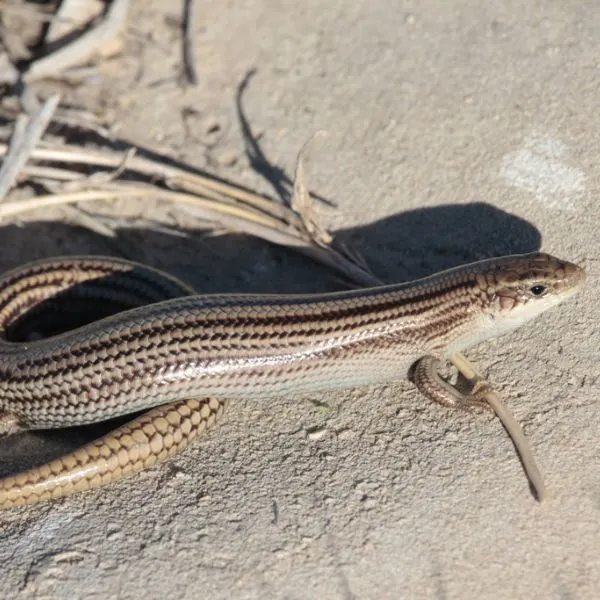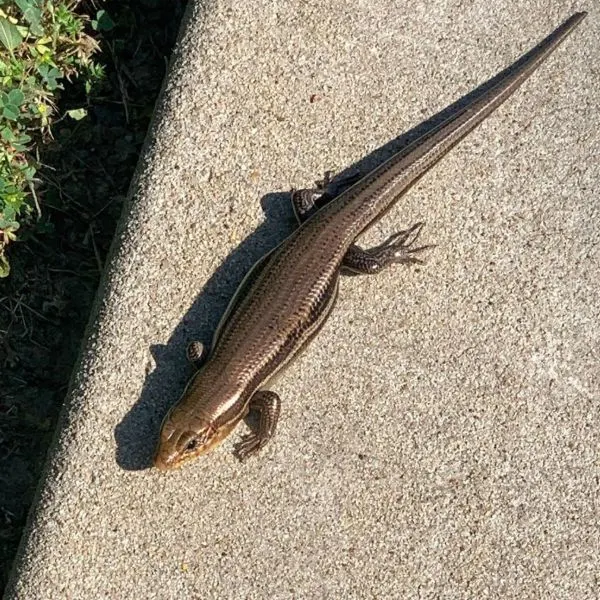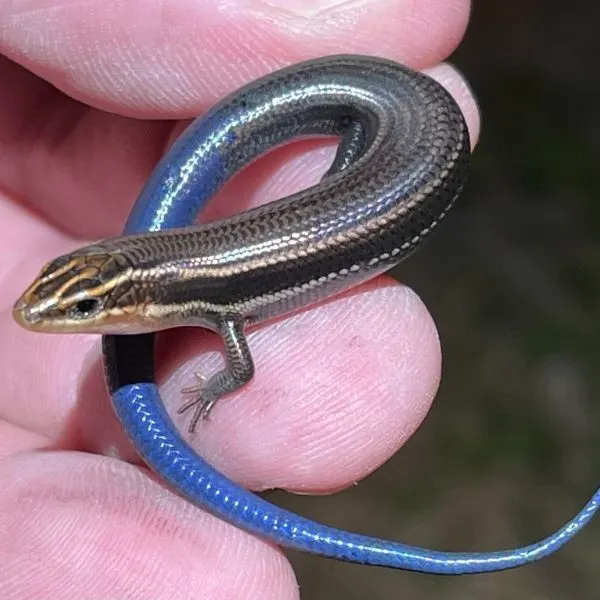There are 8 different types of skinks in Texas. One of several lizard types, skinks have smooth, scaly skin and elongated bodies. The glossy appearance of some species makes them look slippery.
Skinks come in different colors and sizes. While some deceptively look venomous, they all are safe to be around. They love to snack on insects but are not opposed to eating tiny vertebrates.
If you have ever wondered what type of skinks you can find while herping in Texas or are considering adopting a pet skink, this guide contains answers to your questions.
The 8 types of skinks in Texas are all native species. Some are endemic to specific places in the state, while others are widespread. Wherever they are, you will often find them in moist habitats rich in litter and hiding spots.
Table of Contents
Skinks in Texas
1. Many-lined Skink

- Experience Level: Advanced
- Family: Scincidae
- Scientific Name: Plestiodon multivirgatus
- Other Names: Variable Skink
- Adult Size: 5 to 8 inches
- Lifespan: N/A
- Average Price Range: N/A
Young many-lined skinks have black skins with light brown stripes and long, bright blue tails, but they lose most of this coloration as they mature into adults. Adults have light gray to brown bodies lined with multiple stripes running from head to tail.
These lines cause the skinks to have alternating light and dark colors on their backs. You can find some many-lined skinks without this color pattern.
If you are out herping in Texas and want to see this lizard, you are more likely to encounter it on the short grassy plains of the southern panhandle and limestone mountains of the Trans-Pecos.
Patterned many-lined skinks dominate the panhandle grasslands, while those without patterns dominate the Trans-Pecos. They often hide under debris and rocks in the grasslands, but they range more freely on the surface in the Trans-Pecos.
The tail of the many-lined skink is often up to 1.5 longer than its body.
It is not as abundant as other species, so it is on the Texas Parks and Wildlife’s (TPWD) Black List. Unfortunately, that means you cannot legally collect it for commercial reasons.
Many-lined skinks love to feed on arthropods, such as insects and spiders.
2. Prairie Skink

- Experience Level: Advanced
- Family: Scincidae
- Scientific Name: Plestiodon septentrionalis
- Other Names: Northern Prairie Skink
- Adult Size: 4 to 8 inches
- Lifespan: Up to 7 years
- Average Price Range: N/A
You can find prairie skinks hiding under debris and rocks in grasslands or on forest floors with loose sand. These shy skinks love to burrow in sand and prefer moist habitats. They tend to dash for cover when approached.
Prairie skinks look a bit like non-patterned many-lined skinks. However, you can tell the difference between them on close observation. Prairie skinks have dark brown stripes on either side, but many-lined skinks do not.
These lateral stripes on prairie skinks run from the back of the eyes to the tail. The dark stripes have two thin light stripes bordering them. Males develop orange markings on the lips and jaws during breeding seasons.
Most adults have brown to gray skins. They have thick tails and smooth, shiny scales that give them a glossy appearance.
They typically eat spiders and insects like crickets, roaches, and beetles. In addition, adult prairie skinks may eat tiny snails and lizards of other species or even immature members of their species.
Sadly, you cannot legally collect these skinks in Texas because they are on the TPWD Black List. So it is best to leave them alone when you encounter them.
3. Broad-headed Skink

- Experience Level: Intermediate to Advanced
- Family: Scincidae
- Scientific Name: Plestiodon laticeps
- Other Names: Broadhead Scorpion, Broadheaded Skink
- Adult Size: 6 to 13 inches
- Lifespan: 6 to 10 years
- Average Price Range: N/A
Although broadheads do not have prominent necks, male species have a distinct large head. This quality makes it easy to recognize them. They are generally brown, but their heads turn orange during breeding seasons.
Females of this species look different. It is easy to mistake them for five-lined skinks because they retain the juvenile five-line pattern that disappears in male adults.
Juvenile broadhead skinks have black skins and five white or yellow stripes that extend from head to tail. Both sides have a pair of stripes, while one line runs along the back. They also have long, blue tails. Adults of both sexes lose this blue coloration in their tails.
This broadhead skink is the second-largest skink species you can find in Texas. The limbs are sturdy and long when you compare them to other skinks.
Male broadheads are highly territorial against other males but allow females into their spaces. They also are not easy pets to handle.
While broadhead skinks are easy to feed and care for, they do not enjoy close physical contact. They tend to run when you reach for them, but they may bite if they feel threatened and have no place to run.
These lizards also love to climb. They spend a lot of time on exposed tree branches simply basking in the sunlight. No other skink in Texas is as arboreal.
If you plan to adopt one, you must provide elevated basking spots and ultraviolet lighting. Besides its high arthropod diet, make sure it gets a lot of vitamin D from other food sources.
Owing to population decline in certain areas, you are not permitted to collect broadhead skinks in Texas for commercial reasons. Still, you can check the laws in other states where this species is abundant and commercially available.
4. Great Plains Skink

- Experience Level: Beginner to Intermediate
- Family: Scincidae
- Scientific Name: Plestiodon obsoletus
- Other Names: N/A
- Adult Size: 6 to 14 inches
- Lifespan: 3 to 8 years
- Average Price Range: N/A
The Great Plains skink is the largest of the skinks in Texas. Their smooth, overlapping cycloid scales is their distinguishing feature. The arrangement and black, crescent-shaped outline of scales on the back of this species create a net pattern. Their lateral scales also have oblique rather than horizontal rows.
Unlike many skink species, these lizards lack body stripes. Other than the white to yellow markings on the head, young Great Plains skinks have black skin and long, blue tails. Their pitch-black color makes them shimmer in the sun.
In adults, the black skin fades to brown or pale gray, while the thick tails and legs turn yellow to orange. You will notice the lower sides of this lizard have orange markings that ease into a plain or cream-colored belly.
Great Plains skinks are one of the three skink species on the TPWD White List, so you can collect them for commercial purposes.
You can find them in open prairies and rocky or sandy flood plains in the wild. While they burrow, you can often find them on the surface close to their burrows. They do not often bask, so you need not worry about providing ultraviolet light when you keep them in enclosures at home.
You can feed these lizards with insects and arachnids like spiders. Throwing in some nutrient-rich fruits and vegetables now and then will also do them a lot of good.
5. Little Brown Skink

- Experience Level: Advanced
- Family: Scincidae
- Scientific Name: Scincella lateralis
- Other Names: Ground Skink
- Adult Size: 2.25 to 5.75 inches
- Lifespan: 2 to 4 years
- Average Price Range: N/A
As the name suggests, little brown skinks are typically brown. They have a dark brown or black stripe running from snout to tail on either side. Above this line, the skin is dark gold to bronze or copper brown.
These small skinks have yellow or whitish-gray underbellies. Unlike many skinks, the males and females of this species look the same. There is also no color difference between young and adult ground skinks.
Little brown skinks are called ground skinks because they never climb trees. Instead, they enjoy basking on the forest floor and spend their time foraging or traveling under leaf litter and debris.
Their transparent eyelids are an adaptation that helps ground skinks move easily under debris. Their lower eyelids have a gap they can see through even with their eyes closed. This feature is absent in other skinks in Texas.
Ground skinks are shy, tiny creatures, so you might have difficulty taming them into pets. That said, these skinks are abundant in Texas. They are on the TPWD’s White List, so you can purchase them.
Many people who collect ground skinks do so with commercial intent. They sell these small lizards as feed for snakes. You typically need a permit to collect these skinks.
You can feed little brown skinks with insects and other arthropods.
6. Four-lined Skink

- Experience Level: Advanced
- Family: Scincidae
- Scientific Name: Plestiodon tetragrammus
- Other Names: Short-lined Skink, Long-lined Skink
- Adult Size: 3 to 8 inches
- Lifespan: N/A
- Average Price Range: N/A
Four-lined skinks have four light lines on their body. There are two lines on either side bordering an area of dark skin, but these lines never extend beyond the trunk.
There are two very similar subspecies. The lines end at the forelimbs in short-lined skinks (P. t. brevilineatus). P. t. tetragrammus is called the long-lined skink because the lines may extend to the hindlimbs but not beyond.
Four-lined skinks have brown to gray skins and may bear a light Y-shaped marking extending from snout to forehead. Lines and body markings are more prominent in young four-lined skinks. In addition, the young have orange lines on their heads, darker skins, and blue tails, qualities they lose with maturity.
These thick-tailed lizards are endemic to Texas. You can find them in arid areas, forests, scrubs, and woodland, where they often hide under rocks, debris, and leaf litter. They live on insects and other arthropod prey.
You cannot collect this lizard species in Texas for commercial reasons because it is on the TPWD Black List.
7. Five-lined Skink

- Experience Level: Intermediate
- Family: Scincidae
- Scientific Name: Plestiodon fasciatus
- Other Names: Common Five-lined Skink, American Five-lined Skink
- Adult Size: 5 to 8.5 inches
- Lifespan: 6 to 10 years
- Average Price Range: N/A
American five-lined skinks have five light stripes running down their brown to gray bodies. Juveniles have bright blue tails and dark skins. Adults lose this blue tail coloration.
The lines are less prominent in adults. During breeding seasons, their heads turn reddish-orange. They can be mistaken for broadhead skinks or southeastern five-lined skinks. Many taxonomists previously thought five-lined skinks and southeastern five-lined skinks were the same species.
You can differentiate this species from broadheads by its possession of a row of enlarged post-anal scales and four scales along the upper lip. It is also smaller than broadheads.
These lizards are on the TPWD’s White List, so you can purchase them or collect them for commercial reasons. They like moist habitats with leaf litter and logs or tree stumps, so make sure their enclosure is as close to this as possible.
Caring for five-lined skinks is simple because they do not need too much. They are content with a diet of insects and spiders. However, this fact should not stop you from adding more nutritious food to their diet.
Be careful when handling this skink. It is nonvenomous, but it bites when it feels threatened and cannot run.
8. Coal Skink

- Experience Level: Advanced
- Family: Scincidae
- Scientific Name: Plestiodon anthracinus
- Other Names: Coal Skink
- Adult Size: 5 to 7 inches
- Lifespan: N/A
- Average Price Range: N/A
Coal skinks are the most secretive skinks in Texas.
These lizards have a broad dark brown or black stripe on either side. Two light lines border each dark stripe, creating a four-line pattern.
You can differentiate coal skinks from four-lined skinks in Texas by the extension of their dark lateral stripes to their snouts. The difference is not always so clear, however.
The ground color of adult coal skinks is brown, but they are born black with no lines. The young have blue tails and reddish markings on their heads, which they lose as they mature. Male adults develop orange markings on their heads during breeding seasons.
You can find coal skinks in open forests or moist rocky areas, typically close to streams or rivers. They tend to run when approached, diving into streams or under debris. In addition to their sparse population, this quality is why they remain poorly understood.
It is rare to encounter coal skinks, even in their natural ranges. But if you do find them, you will likely catch them foraging or feasting on arthropod prey.
Coal skinks are on the TPWD’s Black List, so you cannot collect them legally or purchase them in Texas.
Wrapping up
Texas is home to several skinks species. Many are beautiful sights to behold, and each species plays a vital role in sustaining the ecosystem.
Since many of the skinks in Texas are banned from the pet trade, you must check the status of any species you want to adopt. In addition to conservation status, consider the lizard’s temperament.
Skinks are beautiful reptiles, and while many are suitable for home terrariums, they all behave differently. Some are fine with handling, while others hate it. So make sure to do adequate research before getting one.
Hopefully, this guide has increased your knowledge about the different skinks in Texas. When next you come across one, we hope you can identify it and tell if it would make a good fit for your terrarium.
Skinks in other states
